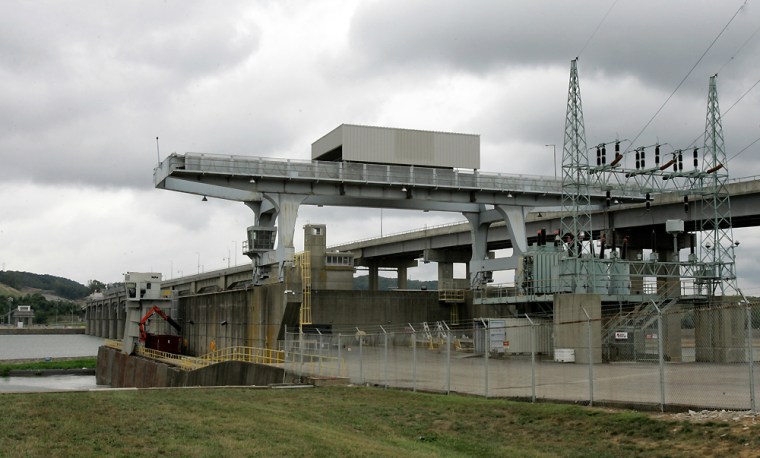Many decades ago, cost-conscious Henry Ford turned to hydroelectric plants to power his car factories like the one by the Great Miami River, near this Cincinnati suburb. That assembly plant is long gone, but the power plant and the technology behind it isn't.
Far from it. The push to get electricity from moving water is only picking up steam.
There is mounting political pressure to get more energy from alternative sources and developers are pushing ambitious projects to exploit America's biggest rivers for power.
"Some of these applications have been around for decades, but there's renewed interest now," said Jeff Hawk, spokesman for the U.S. Army Corps of Engineers' Pittsburgh district. "We've seen a spurt of applications; we're busier now than ever."
A new generation of low-impact hydroelectric plants is expected to light up the Ohio River Valley. Along the Mississippi River, a city and a small startup firm have separate hopes of harnessing that artery's energy potential either through a few big turbines or thousands of tiny, submerged ones.
Water is already the leading renewable energy source used by utilities to generate electric power.
The recent credit crisis has not been a concern for most.
"One thing that is certain is that this will pass," said Dan Irvin, behind one of the ventures planned for the Mississippi River. "If you were financing any energy project at the moment, you'd have your hands full. But we're looking out far enough, and we carry conservative enough assumptions, that we feel very comfortable."
American Municipal Power-Ohio is a nonprofit wholesale power supplier for 123 municipal systems in Ohio, Kentucky, Pennsylvania, Virginia, West Virginia and Michigan. It already owns a hydro plant on the Ohio River and is involved in developing five more.
In Hamilton, Ohio, where the Ford plant once stood, the city bought the hydro power plant in 1963, acquired a second one on the Ohio River a few years later and may soon build another just upriver from Cincinnati.
Hydro gives the 30,000 customers of the city-owned utility the lowest electricity rate in Ohio, and officials think that Hamilton can become virtually all-hydro.
The price tag: $450 million over 40 years.
"The cost is in construction. Once the project's built, that's it," said Linda Church Ciocci, executive director of the National Hydropower Association, a Washington-based trade group. "There's no fuel cost associated with hydropower."
Hamilton's 30,000 residential customers pay 9.7 cents per kilowatt-hour, a couple cents more than the average in Washington state, where 70 percent of its electricity comes from hydropower.
There are 20 navigation and flood control dams on the Ohio River along its 981 miles from Pittsburgh to Cairo, Ill. Hydro plants at six of the dams already are producing electricity, with a generating capacity of more than 300 megawatts; four more that have been licensed would double that perhaps be on line in 2013.
The principle behind hydro is simple. Moving water spins the blades of a turbine, which turns a generator shaft. A fall of less than 30 feet, the height of most Ohio River dams, is sufficient.
Harnessing the Mississippi River's flow for electrical generation isn't new: A 134-megawatt hydroelectric plant by St. Louis-based AmerenUE, for instance, has been running since 1913 at Keokuk, Iowa.
Developers see even more potential, however.
Massachusetts-based Free Flow Power Corp. is studying the prospects of planting thousands of small electric turbines in the river bed at 55 sites from St. Louis to the Gulf of Mexico, figuring together they could generate enough power to supply 1.5 million homes. The private startup says the cumulative output of 1,600 megawatts would be the equivalent of three small coal-fired power plants or one or two nuclear ones.
The plan, with a possible $3 billion price tag, uses hydrokinetics — electrical generation from river currents or ocean waves. The river's flow would spin submerged turbines about two feet in diameter and perhaps made of carbon fiber or some other lightweight source durable enough to withstand being hit by debris swept downriver while not interfering with barge traffic.
"It's elegant, it's simple," says Irvin, Free Flow's chief executive and a former investment banker. His company screened some 80,000 river sites across the country.
Preliminary permits that Free Flow Power already has from the Federal Energy Regulatory Commission give the startup first right to seek operating licenses for projects at those locations while giving it three years to do environmental and technical studies.
Janet Sternberg, a Missouri Department of Conservation policy coordinator, urged FERC months ago to not move too hastily on such projects until more about hydrokinetics is known.
"People saw the Mississippi as an opportunity — here's a big river with a lot of free-flowing water," Sternberg told The Associated Press. "Is this a good place to install this type of energy?"
Irvin calls such debate healthy.
"We have no objection to the careful scrutiny and scientific question," Irvin said. Stressing that Free Flow's turbines would turn only with the speed of the river, "we're pretty comfortable that what we're proposing is going to be completely benign to fish."
Up the river in Quincy, Ill., which hugs the Mississippi's eastern bank, Mayor John Spring thinks installing hydroelectric turbines on three locks and dams could produce 55 megawatts of power — enough to supply the city's 16,000 homes.
Quincy's plan — already signed off on by the City Council and with preliminary permits from FERC — could cost about $200 million.
By the end of this fiscal year, which ends next May, Quincy — a city with an operations budget of $30 million — will have put $1.4 million into the effort.
"We'd like to make this part of our state the poster child for hydroelectricity in our country," Spring said. "Normally, you'd never see an entity this size take on such a gigantic project. But I think it's the future, and it's the right thing to do."
